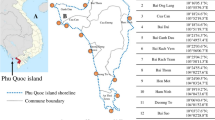Abstract
Controversy over the extent to develop tourism in tourist destinations remains unresolved. This paper examines the extent of tourism development residents are prepared to tolerate in the Lake Bosomtwe. A resident survey undertaken during January 2006 in the basin reveals that residents are more oriented to large scale tourism. The major perceived reason for this preference is that large scale tourism development will help provide for the material needs and wants of the basin’s population. It is concluded that residents of Bosomtwe basin equate large inflows of visitors with success and fame, but field observations indicate that the residents will wreck the basin’s environment if tourism development is left in their sole control.


Similar content being viewed by others
References
Akis, S., Peristianis, N., & Warner, J. (1996). Residents’ attitudes to tourism development: The case of Cyprus. Tourism Management, 17, 481–494.
Begg, D., Fischer, S., & Dornbusch, R. (2003). Economics. London: The McGraw-Hill Companies.
Belisle, F., & Hoy, D. (1980). The perceived impact of tourism by residents: A case study in Santa Marta, Columbia. Annals of Tourism Research, 7, 83–101.
Britton, S. G. (1987). Tourism in small developing countries: development issues and research needs. In: S. G. Britton & W. C. Clarke (Eds.), Ambiguous alternative (pp. 167–187).
Burkey, S. (1998). People first: A guide to self-reliant, participatory rural development. London: Zed Books.
Burton, R. (1995). Travel geography. Great Britain: Pitman Publishing.
Butler, R. W. (1980). The concept of a tourist area cycle of evolution: Implications for management resources. Canadian Geographer, 24, 5–12.
de Kadt, E. (1979). Tourism: Passport to development? New York: Oxford University Press.
Doxey, G. V. (1975). A causation theory of visitor-resident irritants, methodology and research inferences. In Conference proceedings: Sixth annual conference of Travel Research Association (pp. 195–198). San Diego.
Economist (1989). The third world tourism: Visitors are good for you. March, pp. 19–22.
Faulkner, B., & Tideswell, C. (1997). A framework for monitoring community impacts of tourism. Journal of Sustainable Tourism, 5(1), 3–28.
Gardner, G. T., & Stern, P. C. (1996). Environmental problems and human behaviour. London: Allyn and Bacon.
Gartner, W. C. (1996). Tourism development: Principles, processes and policies. USA: Van Nostrand Reinhold.
Guijt, I., & Kaul Shah, M. (1998). The myth of community: Gender issues in participatory development. IT: Intermediate Technology Publications.
Gursoy, D., & Rutherford, D. G., (2004). Host attitudes toward tourism: An improved structural model. Annals of Tourism Research, 31(3), 495–516.
Haley, A. J., Snaith, T., & Miller, G. (2005). The social impacts of tourism: A case study of Bath, UK. Annals of Tourism Research, 32(3), 647–668.
Hardin, G. (1968). The tragedy of the common. Science, 162, 1243–1248.
Himmetoglu, B. (1992). What is soft tourism? In Proceedings of an International Conference on Architecture of Soft Tourism. Trabzon, Turkey: Yildiz University Faculty of Architecture Press.
Husband, W. (1989). Social status and perceptions of Tourism in Zambia. Annals of Tourism Research, 16, 237–255.
Jafari, J. (1989). An english language literature review. In: J. Bystrzanowski (Ed.), Tourism a factor of change: A socio-cultural study (pp. 17–60). Vienna: Centre for Research and Documentation in Social Science.
Jurowski, C., & Gursoy, D. (2004). Distance effects on residents’ attitudes toward tourism. Annals of Tourism Research, 31(2), 296–312.
Keogh, B. (1990). Public participation in community tourism planning. Annals of Tourism Research, 17(3), 449–465.
King, B., Pizam, A., & Milman, A. (1993). Social impacts of tourism: Host perceptions. Annals of Tourism Research, 20, 650–665.
Mader, V. (1988). Tourism and environment. Annals of Tourism Research, 15, 2.
Mansfeld, Y. (1992). Group-differentiated perceptions of social impacts related to tourism development. Professional Geographer, 44, 377–392.
Mathieson, A., & Wall, G. (1982). Tourism: Economic, physical and social impacts. London: Longman.
Miller, G., & Twining-Ward, L. (2005). Monitoring for a sustainable tourism transition: The challenge of developing and using indicators. Oxfordshire: CABI Publishing.
Milman, A., & Pizam, A. (1987). Social impact of tourism on Central Florida. Annals of Tourism Research, 15, 191–204.
Molotch, H. (1976). The city as a growth machine: toward a political economy of place. American Journal of Sociology, 82, 309–322.
Mowforth, M., & Munt, I. (2006). Tourism and sustainability: Development and new tourism in the third world. London: Routledge Taylor & Francis Group.
New Zealand Ministry of Tourism. (1992). Residents’ perception and acceptance of tourism in selected New Zealand Communities, Wellington: Ministry of Tourism.
Rist, G. (1997). History of development. London: Zed Books.
Skinner, B. F. (1938). The behaviour of organism. New York: Appleton-Century-Crofts.
Smith, V. L. (1985). The inuit as host: Heritage and wilderness tourism in Nunavut. In M. F. Price & V. L. Smith (Eds.), People and tourism in fragile environment (pp. 33–55). Chichester: John Wiley and Sons.
Teye, V., Sirakaya, E., & Sonmez, S. (2002). Residents’ attitudes toward tourism development. Annals of Tourism Research, 29, 668–688.
Tosun, C. (2002). Host perceptions of impacts: A comparative tourism study. Annals of Tourism Research, 29, 231–245.
Turner, L., & Ash, J. (1975). The golden hordes: International tourism and The pleasure periphery. London: Constable.
Tyler, C. (1989). A phenomenal explosion. Geographical Magazine, 61(8), 18–21.
WCED (World Commission on Environment and Development). (1987). Our common future (the Brundtland Report). Oxford: Oxford University Press.
Young, G. (1973). Tourism: Blessing or blight? Baltimore: Penguin Books.
Author information
Authors and Affiliations
Corresponding author
Rights and permissions
About this article
Cite this article
Amuquandoh, F.E., Dei, L.A. Tourism development preferences among the residents of Lake Bosomtwe Basin, Ghana. GeoJournal 70, 173–183 (2007). https://doi.org/10.1007/s10708-008-9123-2
Received:
Accepted:
Published:
Issue Date:
DOI: https://doi.org/10.1007/s10708-008-9123-2




